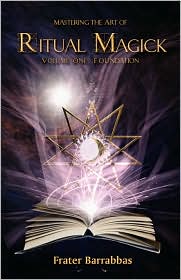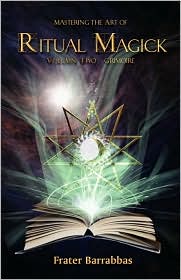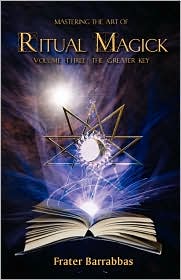


Volume I: Foundation
Volume II: Grimoire
Volume III: The Greater Key
This three-volume series by Frater Barrabbas was written a decade ago, but has only recently found a publisher savvy enough to get in on the burgeoning interest in ceremonial and ritual magick. Frater Barrabbas Tieresias is a founding member of ESSG (Egregore Sancta Stella Gnostica, or Group Spirit of the Holy Stellar Gnosticism, a.k.a. Order of the Gnostic Star, www.gnosticstar.org). Frater Barrabbas’s first book is Disciple’s Guide to Ritual Magick (2007), and this book or something similar should be accessed by beginners. While his personal practices and preferences are Gnostic, the books are designed to offer “modular” applications to intermediate Neo-Pagans/Wiccans, Qabalists, and Gnostics.
The three-volume MARM set covers a copious spectrum of ritual and occult material, including in-depth material on occult philosophy and magickal power and how to generate, focus, and release it. The strength of these texts is also the weakness: there are lots of bits and parts that the reader may or may not find valuable or applicable. The reader must decide what s/he wants to incorporate into a ritual. These books tell a practitioner what to do, but are not always forthcoming about how to do it.
In Volume I, the author supplies excellent chapters on Magickal Identity and elemental ritual tools. There are descriptions of magickal models like the Tree of Life, and methods of mind control, trance states, visualization and similar mind-altering techniques necessary for performing successful ritual magick. Where this book really shines is in Chapter 9: “Initiations: Cycles of Revelations.” The author outlines a 22-stage cycle of initiation for men, drawing on both Joseph Campbell and the Major Arcana of the Tarot. A similar cycle of initiation for women is described, but it was incomplete and unhelpful. After the author grandstanded about the long-term subjugation and oppression of women, it was hypocritical to offer a stripped down, inadequate summary of the women’s initiation rite. Even if the author failed here, why didn’t an editor catch this?
Volume II: Grimoire contains information about the Sephiroth and Qabalah, occult themes, more about ritual structures, seasons and elementals, God names, information about group workings, and includes several texts for full rituals.
Volume III: The Greater Key supplies correspondence tables for tailoring the rituals in Volume II to one’s spiritual tradition. The author describes the internal structure of the Tarot, and outlines a Gates of Transformation ritual. The last few chapters of this text give tips about starting and working in a ritual magick group, along with a list of everything that can go wrong with that plan! This was followed by the bylaws of ESSG and appeals for members. Volume III has some editing issues with typos and formatting gaffes.
The correspondence tables given in Volume III are dicey. What a place to fall down and go boom! The correspondences are the key to creating “modular” rituals, but didn’t seem to get the attention they deserved to fulfill the author’s intention. For example, the correspondences between the Sephiroth and Greek gods are bizarre: Father God/Osiris = Athena? God of Justice/Amon – Poseidon? How can that slippery, underhanded rapist Poseidon be associated with anything resembling justice? And why use Greek gods in the list? Wiccans use the Celtic pantheon, and the Greek pantheon is used by a fraction of Neo-Pagans. The associations between the Sabbats and the Court cards are just plain weird. The author has a theoretical/qabbalistic grasp of the tarot and astrology, but lacks an understanding of practical applications. A huge section of Volume III is instructions for filling in the blanks in the “modular” rituals supplied in Volume II with these questionable correspondences. Why isn’t this content in Volume II, side-by-side with the rituals?
Let’s be very clear about the content: what these volumes offer are rituals and approaches to ritual based on techniques of ceremonial magick. The “modular” material is intended to be tailored for personal use, and that’s a very good concept. Unfortunately, the concept falls flat in execution because the material is scattered through three volumes, making it difficult and annoying to do this. The secondary intention of offering three-fold correspondences for Neo-Pagans, Qabalists, and Gnostics is another very good idea that would have succeeded with better research or even – wait for it – advice from experts in those traditions! The magick is focused on self-improvement and transformation. There are no instructions on making talismans and other common operations of ritual magick. But if you join ESSG, you can get tons of elemental magick rituals, along with tips on talismanic magick, theurgy, sacramentation, and archeomancy. Rope a dope!
In the end, I’m hedging this review with “buyer beware” and “some assembly required” signs. There’s valuable information and some well-written sections offering material not commonly found elsewhere. But the potential buyer should be aware that these are not books of spells or straight-forward how-to guides. The reader would be well advised to do his/her own research before filling in the blanks. Better yet – select bits to use in your own rituals. I would have liked these books much more if the content was organized for ease of use by the reader, and not targeted to selling more books and group memberships. The scammy tactic of scattering related information through three volumes (at $20+ a book) along with the shameless plugs for ESSG left me feeling like I’d been ambushed by a magickal infomercial.
~review by Elizabeth Hazel
Author: Frater Barrabbas Tieresias
Megalithica/Immanion Press
Vol I: 2008, 200 pp, $21.99.
Vol II: 2009, 200 pp, $20.99
Vol III: 2010, 204 pp, $20.99
